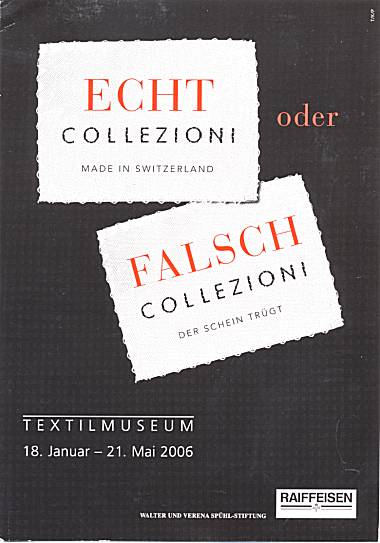| |
Fakes
in the 15th century
Eastern Swiss textile manufacturers
expanded their commercial interests beyond the national
borders at an early stage. In the 15th century, St.Gallen
linen was sold throughout Europe and from Morocco to
Syria and Persia. Part of the "white gold's"
success was quality assurance. The good fabrics received
were marked with "G", a quality seal recognised
in all the markets. Old documents evince, however, that
such seals were no protection against fakes. In 1477, for
example, an Arbon merchant was exposed who offered linen
fabrics marked with a faked "G" at a Frankfurt
trade fair.
French products from Eastern Switzerland
From the second half of the 18th century onwards,
Eastern Swiss women started to embroider muslin, with
Appenzell women proving particularly skilful. French
companies from Paris and Nancy sent fabrics on which
patterns had been printed to the Appenzellerland to be
embroidered there. In the 1830s, the Appenzell embroidery
firms emancipated themselves and designed their own
patterns. Even so, France still sold Appenzell
embroideries as its own products as late as the World
Exhibition of 1889.
"Hamburghs" from St. Gallen in North America
In 1853, a Hamburg businessman purchased a large
volume of machine embroideries in St.Gallen for a New
York company. In the US, he sold them as
"Hamburghs" in order to deceive his competitors
about the actual source of these new articles. It was not
long, however, before North American customers bought
their goods directly in St.Gallen.
Industrial espionage
he city of Plauen in Saxony carried out industrial
espionage in 1857 by moving a hand-embroidery machine
from St.Gallen to Plauen and wooed the necessary
mechanics and embroiderers away from St.Gallen.
On the look-out for better earnings, Eastern Swiss
embroiderers and their families moved to St. Quentin
(Department of Aisne, France) in the late 19th century.
Both Plauen and St. Quentin became St.Gallen's
competitors
St. Gallen embroidery from Plauen
Imitations of genuine lace
The development of machine-produced embroideries was
perfected on a constant basis. Only experts remained able
to distinguish between high-quality machine embroidery
and hand embroidery.
For resourceful St.Gallen businessmen, the invention of
burnt-out embroidery in 1883 opened up broad new horizons
for the embroidered imitation of hand-made lace. The
so-called "St.Gallen lace" would earn world
renown.
In the 19th century, Switzerland had textile finishing
agreements with various countries. This meant that
fabrics could be embroidered, or the embroideries on them
completed, in other countries more or less without
payment of customs duties. Thus, in times of great
demand, St.Gallen companies had part of their products
finished in the Austrian Vorarlberg or in Saxon Plauen.
Conversely, they finished woollen fabrics for English
companies. France did not permit any finishing trade,
which prompted St.Gallen firms to operate embroidery
machines in France.
Product piracy – more topical than ever
The big issue for the embroidery industry has always
been the imitation of patterns. Newly designed patterns
provided no guarantee that the general public would like
them. The imitators of embroideries were able to wait for
the most popular patterns without making large-scale
investments in new designs, and pattern pirates increased
their profits by reducing the number of stitches and by
using cheaper materials.
Ten to fifteen years ago, digital technology made it
possible for patterns to be copied a short time after the
presentation of the latest collections. Clothes
manufacturers were thus able to have their fabrics
produced at low cost without having to order the
expensive originals from Swiss companies.
In more recent years, it has not only been the patterns
that have been copied, but even finished products such as
entire garments or accessories. The losses that such
fakes generate for the Swiss textile industry run into
millions of francs
Ursula Karbacher, lic. phil. I, Curator |
